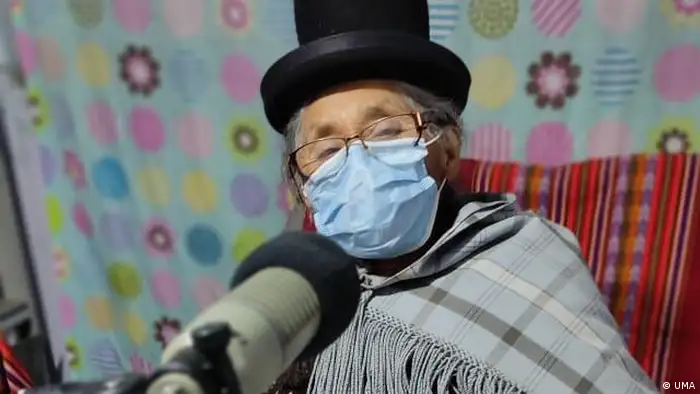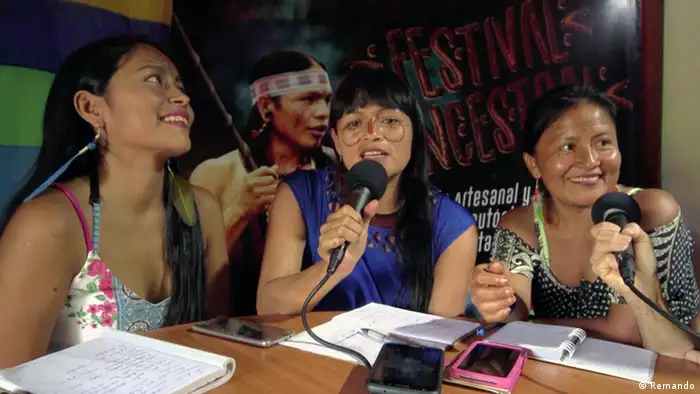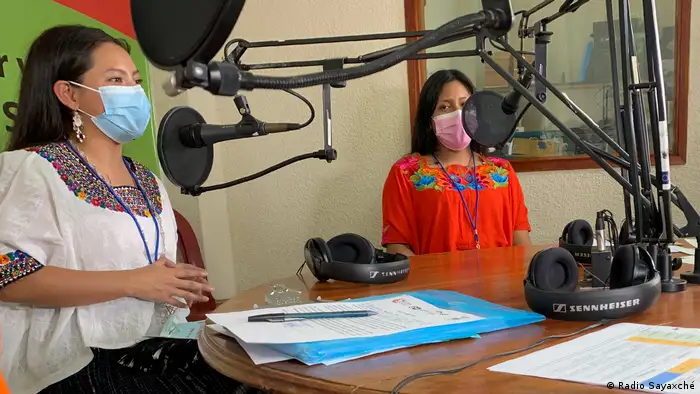Regions
A "Beehive" named Colmena: Technological responses for local and community media
The pandemic has weakened local and community media right when their reporting was most needed. However, many have turned this challenge into an opportunity.

The Unión de Mujeres Aymaras de Abya Yala (UMA), a member of DW Akademie’s Colmena project, informs rural populations in southern Peru in the native language
"Our program was paralyzed for about two months, because almost the entire community where the radio studio is located was infected with COVID-19” says Mariana Canelos, producer of the Amazon podcast Remando, member of the Confederation of Indigenous Nationalities of the Ecuadorian Amazon. The impact that the COVID-19 pandemic had and still has on her work is tremendous. "We looked for a way to work via the internet, but although we live in urban areas, there is no electricity or cellular coverage."
Despite the importance of the media in combating misinformation, dozens of local and community media in Latin America, Asia and Africa have had to stop broadcasting because of the health crisis, just like Remando. These media are often the only source of reliable information for communities.
However, these media have also demonstrated a great capacity for resilience, as evidenced by research conducted by DW Akademie with community radio stations, regional networks and digital media in Africa and Latin America. This research is part of the Colmena project, a collaborative virtual newsroom that aims to strengthen the resilience of local and community media for future crises.

From the Ecuadorian Amazon, a team of women produces the podcast Remando to inform local communities.
The needs of local media
Twenty-two in-depth interviews and 34 surveys were conducted. They showed an increase in the use of digital information and communication technologies. Internet connectivity is a challenge, but most of the interview participants were able to use videoconferencing platforms such as Zoom or Google Meet. However, connectivity worsens in rural or very remote areas, such as the Amazon region, where Mariana Canelos works.
Another finding was the increased use of cell phones among the participating media. Some of the media workers do not have a computer at home and were not able to travel to the radio station because of restrictions imposed by the government to prevent the spread of COVID-19. Consequently, the mobile phone became an indispensable tool for their journalistic work.
"Now the cell phone is becoming a new normal," says Michelle Njeri of Radio Amani in Kenya, who experienced it firsthand. She had to work from home, communicating via phone with Radio Amani, so that she could still provide reliable information to her audience.

Local radio stations, such as Radio Amani in Kenya, are often the only source of information for the population and become even more important in times of crisis.
Turning challenges into opportunities
Necessity was the main stimulus. The pandemic has forced media workers to explore new tools and become self-trained. The journalists learned how to use those tools by watching internet tutorials, organizing workshops within the team or asking other media partners.
For Aldo Moro, director of Radio Sayaxché in Guatemala, the challenge became a learning opportunity: "The pandemic allowed us to say: We do have the technology to interview whoever we want, even if they are in the capital or in another country. We already know how to do it. There's no turning back."
These new technologies are here to stay, but are in very limited use, partly because connectivity is not stable outside the main cities in the Global South. Therefore, preference should be given to applications that allow working locally and synchronize once connected to the Internet.
Looking into the future
Mariana Canelos, Michelle Njeri and Aldo Moro are still fighting every day just to do their jobs — being journalists in the era of COVID-19. There is an urgent need for training and support. Many media outlets know how to use online tools and platforms, but having to integrate several of them into their daily production routines is a constant pain in the neck.
This is where Colmena, developed by DW Akademie and project partners in Africa and Latin America, is helping: in Spanish it means "Beehive". It is a digital ecosystem where all contributions are welcome. An open source, virtual newsroom to produce content from home, edit it and then share it online. It is even available offline and older devices can also run the free App. So, journalists can concentrate on collecting the "honey" — which is reliable information. It's secure and private — yet open to all.
This project is part of the global initiative "Transparency and media freedom - Crisis resilience in the pandemic" which is funded by the German Federal Ministry for Economic Cooperation and Development (BMZ).
- Date 06.08.2021
- Author Nils Brock, Vivienne Gager, Santiago García Gago
- Feedback: Send us your feedback.
- Print Print this page
- Permalink https://p.dw.com/p/3ydGf
- Date 06.08.2021
- Author Nils Brock, Vivienne Gager, Santiago García Gago
- Send us your feedback.
- Print Print this page
- Permalink https://p.dw.com/p/3ydGf

